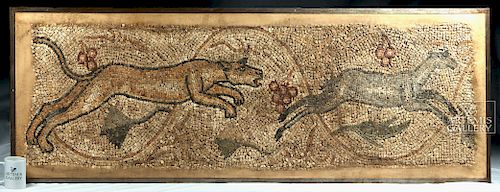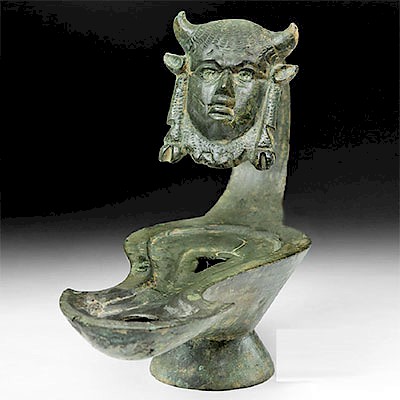Huge / Impressive Roman Mosaic of a Stag Hunt
Lot 57b
About Seller
Artemis Fine Arts
686 S Taylor Ave, Ste 106
Louisville, CO 80027
United States
Selling antiquities, ancient and ethnographic art online since 1993, Artemis Gallery specializes in Classical Antiquities (Egyptian, Greek, Roman, Near Eastern), Asian, Pre-Columbian, African / Tribal / Oceanographic art. Our extensive inventory includes pottery, stone, metal, wood, glass and textil...Read more
Estimate:
$18,000 - $25,000
Absentee vs Live bid
Two ways to bid:
- Leave a max absentee bid and the platform will bid on your behalf up to your maximum bid during the live auction.
- Bid live during the auction and your bids will be submitted real-time to the auctioneer.
Bid Increments
| Price | Bid Increment |
|---|---|
| $0 | $25 |
| $300 | $50 |
| $1,000 | $100 |
| $2,000 | $250 |
| $5,000 | $500 |
| $10,000 | $1,000 |
| $20,000 | $2,500 |
| $50,000 | $5,000 |
| $100,000 | $10,000 |
| $200,000 | $20,000 |
About Auction
By Artemis Fine Arts
Sep 27, 2018
Set Reminder
2018-09-27 10:00:00
2018-09-27 10:00:00
America/New_York
Bidsquare
Bidsquare : Antiquities | Asian | Ethnographic
https://www.bidsquare.com/auctions/artemis-gallery/antiquities-asian-ethnographic-3469
Featuring classical antiquities, ancient and ethnographic art from cultures encompassing the globe. Artemis Fine Arts info@artemisgallery.com
Featuring classical antiquities, ancient and ethnographic art from cultures encompassing the globe. Artemis Fine Arts info@artemisgallery.com
- Lot Description
Roman or early Byzantine, the Levant, late Imperial Period, ca. 5th to 6th century CE. A massive, lively mosaic depicting a dog chasing a stag. The bulk of the image is of the dog, her body stretched out as she runs, her tail streaming behind her and her ears flattened back as she pursues her quarry. The stag is close ahead, its body also stretched out in full flight. Round shapes in the background as well as grape vines and leaves give the impression that the animals are chasing each other through a field. Size of mosaic: 69" W x 19" H (175.3 cm x 48.3 cm); size of frame: 73" W x 24" H (185.4 cm x 61 cm)
The iconography of the stag hunt is a common one in Roman mosaics, used to illustrate the wealth and prestige of the owner of the mosaic. Elite Romans reveled in hunting not as a way of putting food on the table, but as a way to demonstrate that they had the leisure time to pursue it. Hunting dogs also enjoyed special affection, immortalized by a number of Roman writers. For example, in the "Cynegetica" (ca. 283 to 284 CE), a poem dedicated to Caracalla, the author describes a type of hound "for the swift chase of gazelle and deer and swift-footed hare," perhaps the exact type depicted here.
Mosaics (opus tesellatum) are some of our enduring images from the Roman world, not only for their aesthetic beauty, but also because they reveal what Romans chose to depict and see every day decorating their private and public spaces. In the Roman province of Syria, which encompassed most of the ancient Near East/Levant, mosaics seem to have developed as a common art form relatively late, with most finds coming from the 3rd century CE or later. Syria was one of Rome's wealthiest provinces, but it was also far removed from Rome itself and Roman culture was overlaid on enduring cultural traditions from Hellenistic Greece and the great civilizations that came before it. For example, Antioch-on-the-Orontes (modern day Antakya, Turkey), was the capital of northern Roman Syria, and its excavations in the 1930s revealed more than three hundred mosaic pavements. This mosaic was probably in a private home.
Provenance: private Davis collection, Houston, Texas, USA; ex-Gerhard Hirsch Nachfolger Auction 277-280 - Ancient Objects, Coins, and Medals (February 8-11, 2012, lot 546); ex-private old French collection
All items legal to buy/sell under U.S. Statute covering cultural patrimony Code 2600, CHAPTER 14, and are guaranteed to be as described or your money back.
A Certificate of Authenticity will accompany all winning bids.
We ship worldwide and handle all shipping in-house for your convenience.
#138424Mounted on concrete with a metal frame. Small losses around edges and a few missing tesserae throughout, but the image is very clear and no detail is lost. Otherwise in very nice condition with light encrustation in between the tesserae.Condition
- Shipping Info
-
All shipping is handled in-house for your convenience. Your invoice from Artemis Gallery will include shipping calculation instructions. If in doubt, please inquire BEFORE bidding for estimated shipping costs for individual items.
-
- Buyer's Premium



 EUR
EUR CAD
CAD AUD
AUD GBP
GBP MXN
MXN HKD
HKD CNY
CNY MYR
MYR SEK
SEK SGD
SGD CHF
CHF THB
THB















